Analyzing Governance Failures: Bundaberg Hospital Case Study
VerifiedAdded on 2023/06/07
|6
|1418
|182
Case Study
AI Summary
This case study examines the organizational governance and performance management failures at Bundaberg Hospital, focusing on the hiring and supervision of Dr. Jawant Patel and the subsequent patient deaths. It highlights the lack of background checks, failure to verify credentials, and the muting of employee voices, particularly nurses who raised concerns. The study also discusses the hospital's governance systems' inability to prevent clinical failings due to resource constraints and structural deficiencies. The case emphasizes the importance of proper credentialing, certification, and responsive governance structures to ensure patient safety and quality healthcare services, further noting how whistleblowers were threatened, ultimately requiring external intervention to address the issues.
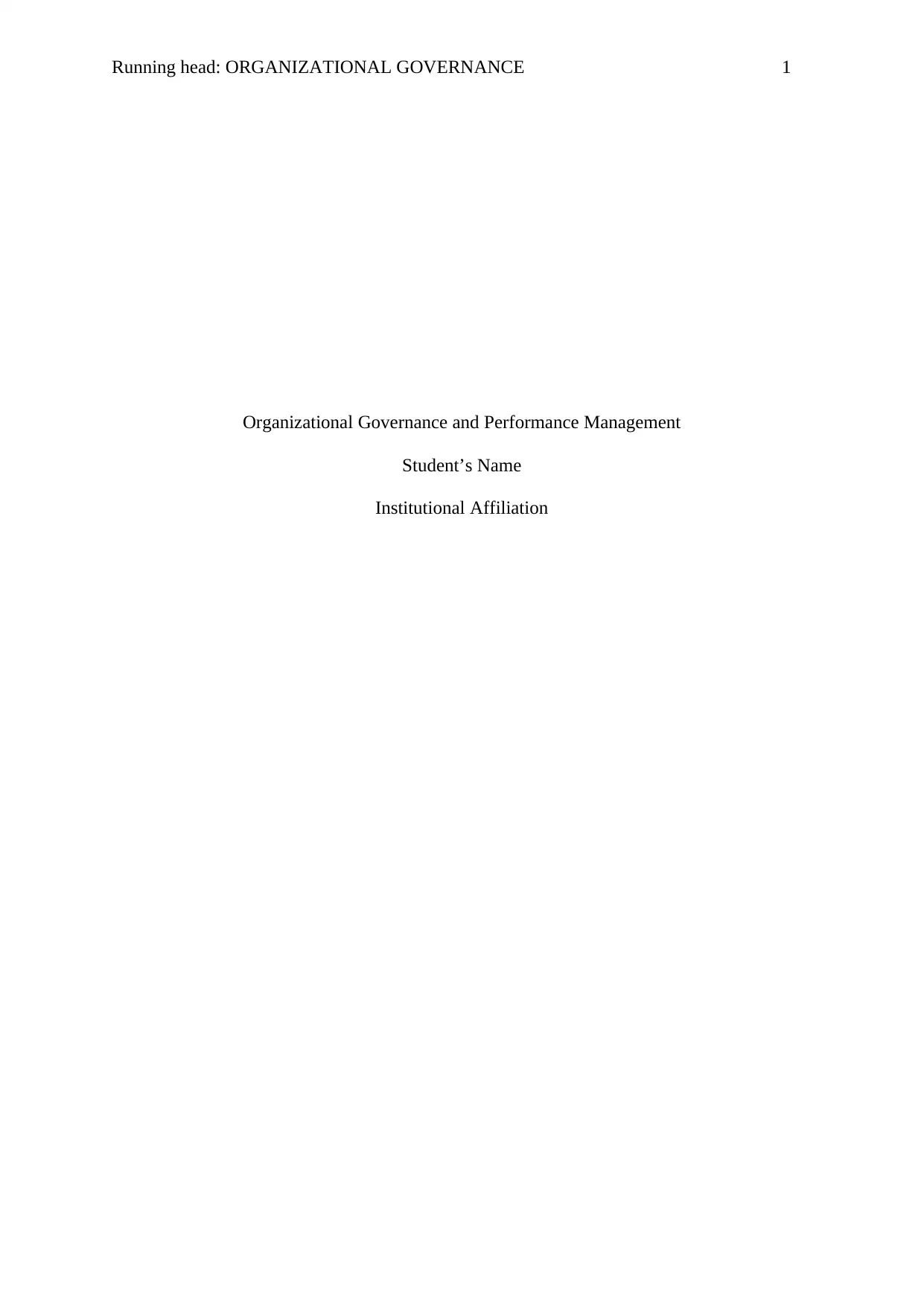
Running head: ORGANIZATIONAL GOVERNANCE 1
Organizational Governance and Performance Management
Student’s Name
Institutional Affiliation
Organizational Governance and Performance Management
Student’s Name
Institutional Affiliation
Paraphrase This Document
Need a fresh take? Get an instant paraphrase of this document with our AI Paraphraser
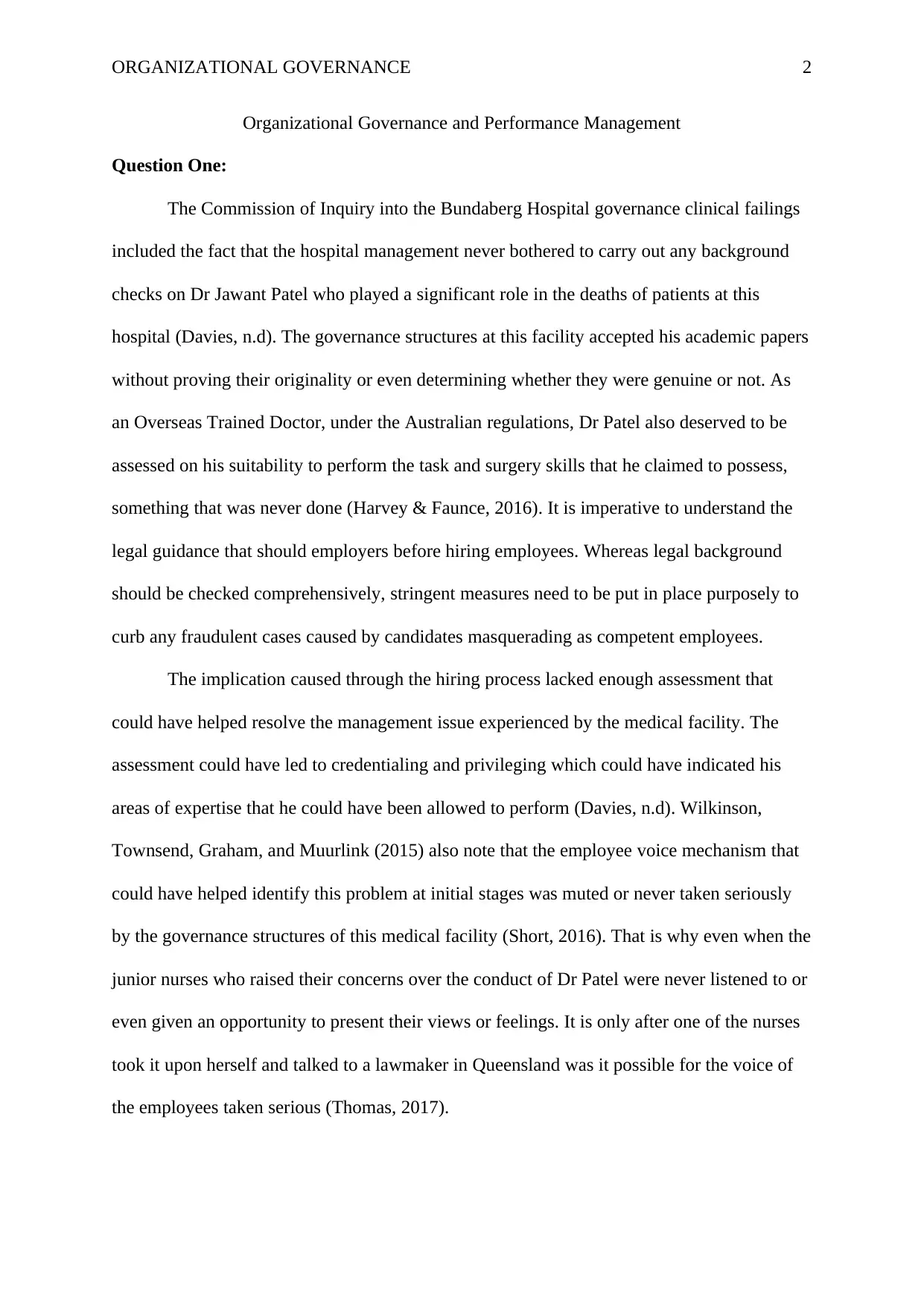
ORGANIZATIONAL GOVERNANCE 2
Organizational Governance and Performance Management
Question One:
The Commission of Inquiry into the Bundaberg Hospital governance clinical failings
included the fact that the hospital management never bothered to carry out any background
checks on Dr Jawant Patel who played a significant role in the deaths of patients at this
hospital (Davies, n.d). The governance structures at this facility accepted his academic papers
without proving their originality or even determining whether they were genuine or not. As
an Overseas Trained Doctor, under the Australian regulations, Dr Patel also deserved to be
assessed on his suitability to perform the task and surgery skills that he claimed to possess,
something that was never done (Harvey & Faunce, 2016). It is imperative to understand the
legal guidance that should employers before hiring employees. Whereas legal background
should be checked comprehensively, stringent measures need to be put in place purposely to
curb any fraudulent cases caused by candidates masquerading as competent employees.
The implication caused through the hiring process lacked enough assessment that
could have helped resolve the management issue experienced by the medical facility. The
assessment could have led to credentialing and privileging which could have indicated his
areas of expertise that he could have been allowed to perform (Davies, n.d). Wilkinson,
Townsend, Graham, and Muurlink (2015) also note that the employee voice mechanism that
could have helped identify this problem at initial stages was muted or never taken seriously
by the governance structures of this medical facility (Short, 2016). That is why even when the
junior nurses who raised their concerns over the conduct of Dr Patel were never listened to or
even given an opportunity to present their views or feelings. It is only after one of the nurses
took it upon herself and talked to a lawmaker in Queensland was it possible for the voice of
the employees taken serious (Thomas, 2017).
Organizational Governance and Performance Management
Question One:
The Commission of Inquiry into the Bundaberg Hospital governance clinical failings
included the fact that the hospital management never bothered to carry out any background
checks on Dr Jawant Patel who played a significant role in the deaths of patients at this
hospital (Davies, n.d). The governance structures at this facility accepted his academic papers
without proving their originality or even determining whether they were genuine or not. As
an Overseas Trained Doctor, under the Australian regulations, Dr Patel also deserved to be
assessed on his suitability to perform the task and surgery skills that he claimed to possess,
something that was never done (Harvey & Faunce, 2016). It is imperative to understand the
legal guidance that should employers before hiring employees. Whereas legal background
should be checked comprehensively, stringent measures need to be put in place purposely to
curb any fraudulent cases caused by candidates masquerading as competent employees.
The implication caused through the hiring process lacked enough assessment that
could have helped resolve the management issue experienced by the medical facility. The
assessment could have led to credentialing and privileging which could have indicated his
areas of expertise that he could have been allowed to perform (Davies, n.d). Wilkinson,
Townsend, Graham, and Muurlink (2015) also note that the employee voice mechanism that
could have helped identify this problem at initial stages was muted or never taken seriously
by the governance structures of this medical facility (Short, 2016). That is why even when the
junior nurses who raised their concerns over the conduct of Dr Patel were never listened to or
even given an opportunity to present their views or feelings. It is only after one of the nurses
took it upon herself and talked to a lawmaker in Queensland was it possible for the voice of
the employees taken serious (Thomas, 2017).
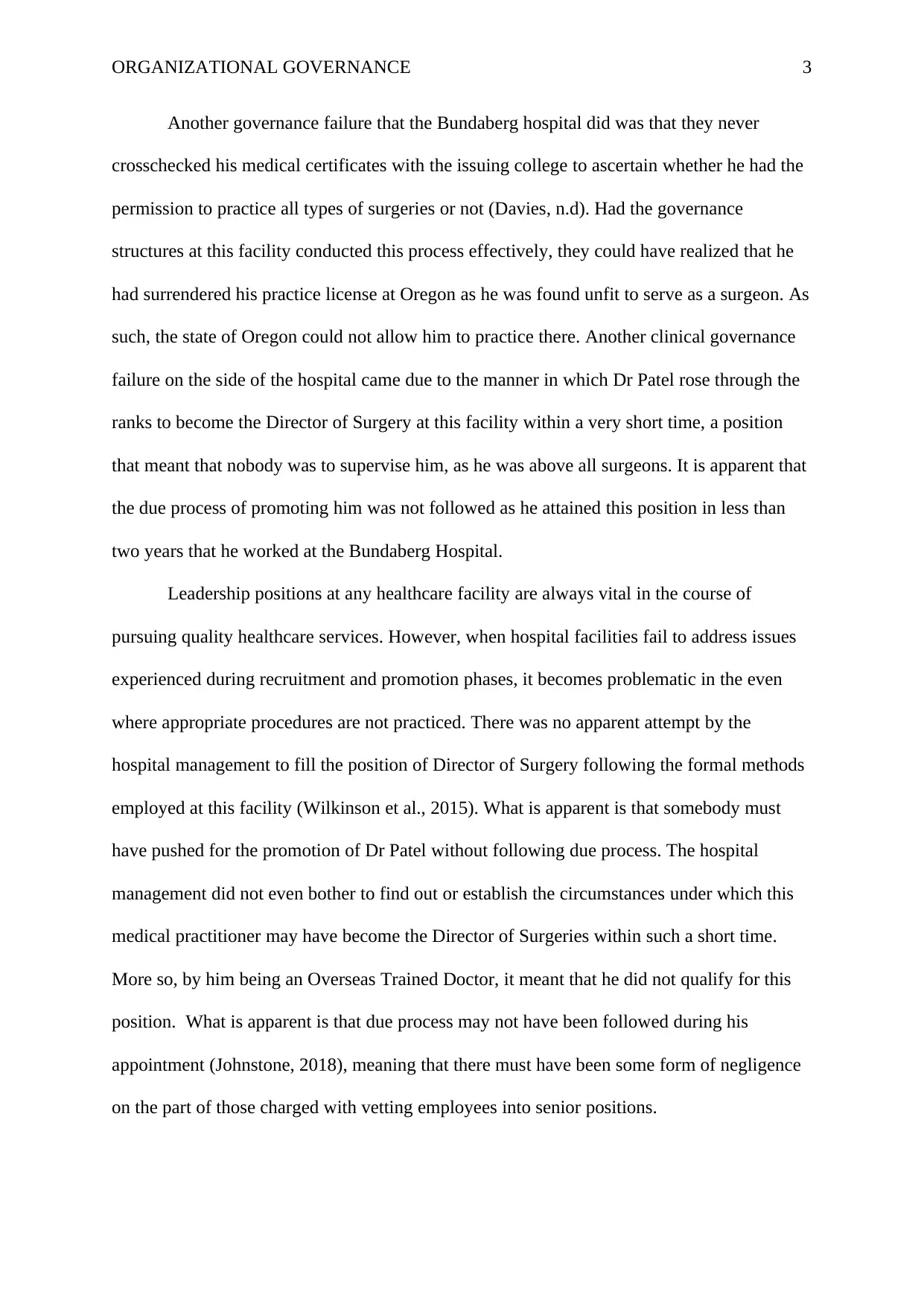
ORGANIZATIONAL GOVERNANCE 3
Another governance failure that the Bundaberg hospital did was that they never
crosschecked his medical certificates with the issuing college to ascertain whether he had the
permission to practice all types of surgeries or not (Davies, n.d). Had the governance
structures at this facility conducted this process effectively, they could have realized that he
had surrendered his practice license at Oregon as he was found unfit to serve as a surgeon. As
such, the state of Oregon could not allow him to practice there. Another clinical governance
failure on the side of the hospital came due to the manner in which Dr Patel rose through the
ranks to become the Director of Surgery at this facility within a very short time, a position
that meant that nobody was to supervise him, as he was above all surgeons. It is apparent that
the due process of promoting him was not followed as he attained this position in less than
two years that he worked at the Bundaberg Hospital.
Leadership positions at any healthcare facility are always vital in the course of
pursuing quality healthcare services. However, when hospital facilities fail to address issues
experienced during recruitment and promotion phases, it becomes problematic in the even
where appropriate procedures are not practiced. There was no apparent attempt by the
hospital management to fill the position of Director of Surgery following the formal methods
employed at this facility (Wilkinson et al., 2015). What is apparent is that somebody must
have pushed for the promotion of Dr Patel without following due process. The hospital
management did not even bother to find out or establish the circumstances under which this
medical practitioner may have become the Director of Surgeries within such a short time.
More so, by him being an Overseas Trained Doctor, it meant that he did not qualify for this
position. What is apparent is that due process may not have been followed during his
appointment (Johnstone, 2018), meaning that there must have been some form of negligence
on the part of those charged with vetting employees into senior positions.
Another governance failure that the Bundaberg hospital did was that they never
crosschecked his medical certificates with the issuing college to ascertain whether he had the
permission to practice all types of surgeries or not (Davies, n.d). Had the governance
structures at this facility conducted this process effectively, they could have realized that he
had surrendered his practice license at Oregon as he was found unfit to serve as a surgeon. As
such, the state of Oregon could not allow him to practice there. Another clinical governance
failure on the side of the hospital came due to the manner in which Dr Patel rose through the
ranks to become the Director of Surgery at this facility within a very short time, a position
that meant that nobody was to supervise him, as he was above all surgeons. It is apparent that
the due process of promoting him was not followed as he attained this position in less than
two years that he worked at the Bundaberg Hospital.
Leadership positions at any healthcare facility are always vital in the course of
pursuing quality healthcare services. However, when hospital facilities fail to address issues
experienced during recruitment and promotion phases, it becomes problematic in the even
where appropriate procedures are not practiced. There was no apparent attempt by the
hospital management to fill the position of Director of Surgery following the formal methods
employed at this facility (Wilkinson et al., 2015). What is apparent is that somebody must
have pushed for the promotion of Dr Patel without following due process. The hospital
management did not even bother to find out or establish the circumstances under which this
medical practitioner may have become the Director of Surgeries within such a short time.
More so, by him being an Overseas Trained Doctor, it meant that he did not qualify for this
position. What is apparent is that due process may not have been followed during his
appointment (Johnstone, 2018), meaning that there must have been some form of negligence
on the part of those charged with vetting employees into senior positions.
⊘ This is a preview!⊘
Do you want full access?
Subscribe today to unlock all pages.

Trusted by 1+ million students worldwide
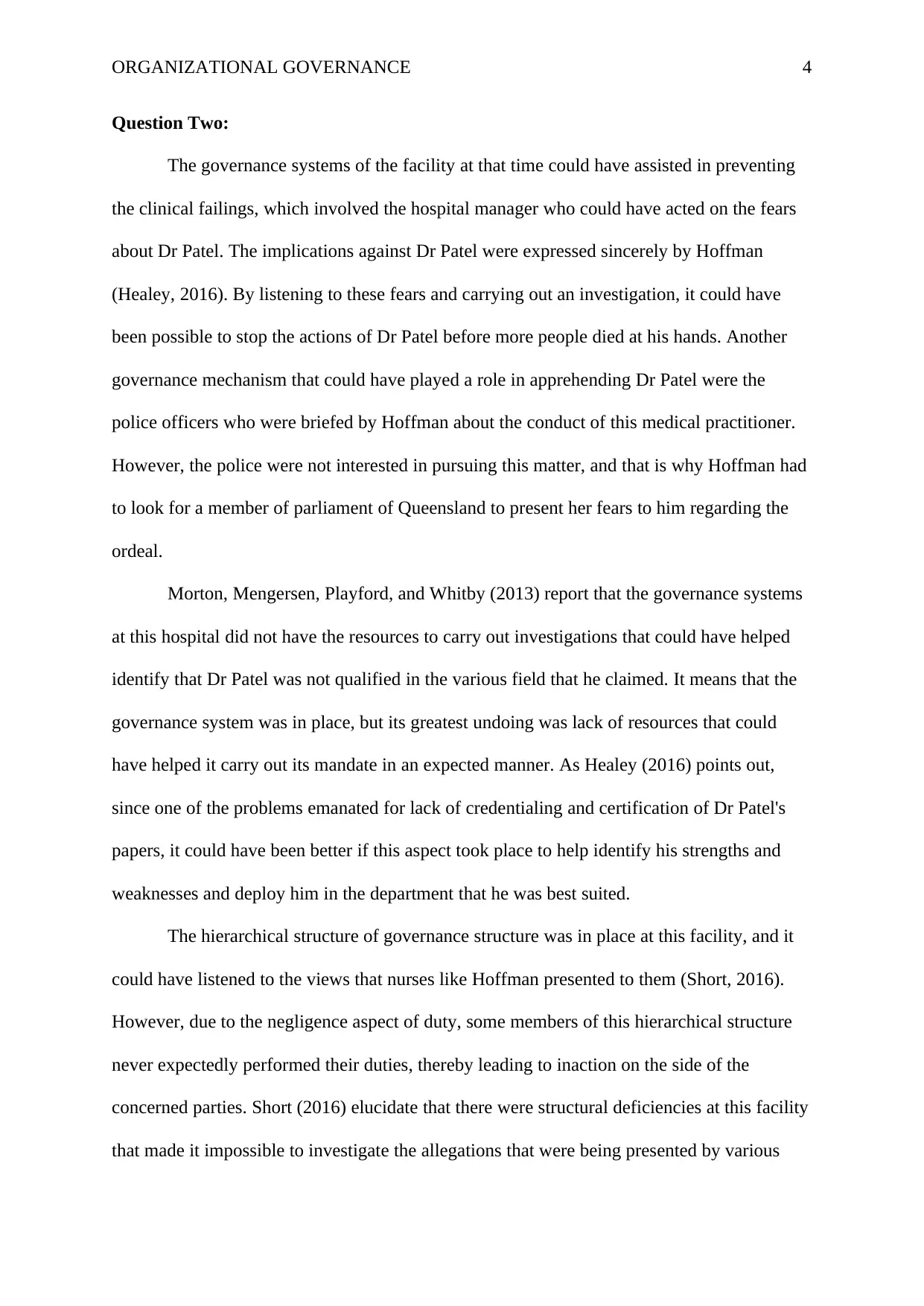
ORGANIZATIONAL GOVERNANCE 4
Question Two:
The governance systems of the facility at that time could have assisted in preventing
the clinical failings, which involved the hospital manager who could have acted on the fears
about Dr Patel. The implications against Dr Patel were expressed sincerely by Hoffman
(Healey, 2016). By listening to these fears and carrying out an investigation, it could have
been possible to stop the actions of Dr Patel before more people died at his hands. Another
governance mechanism that could have played a role in apprehending Dr Patel were the
police officers who were briefed by Hoffman about the conduct of this medical practitioner.
However, the police were not interested in pursuing this matter, and that is why Hoffman had
to look for a member of parliament of Queensland to present her fears to him regarding the
ordeal.
Morton, Mengersen, Playford, and Whitby (2013) report that the governance systems
at this hospital did not have the resources to carry out investigations that could have helped
identify that Dr Patel was not qualified in the various field that he claimed. It means that the
governance system was in place, but its greatest undoing was lack of resources that could
have helped it carry out its mandate in an expected manner. As Healey (2016) points out,
since one of the problems emanated for lack of credentialing and certification of Dr Patel's
papers, it could have been better if this aspect took place to help identify his strengths and
weaknesses and deploy him in the department that he was best suited.
The hierarchical structure of governance structure was in place at this facility, and it
could have listened to the views that nurses like Hoffman presented to them (Short, 2016).
However, due to the negligence aspect of duty, some members of this hierarchical structure
never expectedly performed their duties, thereby leading to inaction on the side of the
concerned parties. Short (2016) elucidate that there were structural deficiencies at this facility
that made it impossible to investigate the allegations that were being presented by various
Question Two:
The governance systems of the facility at that time could have assisted in preventing
the clinical failings, which involved the hospital manager who could have acted on the fears
about Dr Patel. The implications against Dr Patel were expressed sincerely by Hoffman
(Healey, 2016). By listening to these fears and carrying out an investigation, it could have
been possible to stop the actions of Dr Patel before more people died at his hands. Another
governance mechanism that could have played a role in apprehending Dr Patel were the
police officers who were briefed by Hoffman about the conduct of this medical practitioner.
However, the police were not interested in pursuing this matter, and that is why Hoffman had
to look for a member of parliament of Queensland to present her fears to him regarding the
ordeal.
Morton, Mengersen, Playford, and Whitby (2013) report that the governance systems
at this hospital did not have the resources to carry out investigations that could have helped
identify that Dr Patel was not qualified in the various field that he claimed. It means that the
governance system was in place, but its greatest undoing was lack of resources that could
have helped it carry out its mandate in an expected manner. As Healey (2016) points out,
since one of the problems emanated for lack of credentialing and certification of Dr Patel's
papers, it could have been better if this aspect took place to help identify his strengths and
weaknesses and deploy him in the department that he was best suited.
The hierarchical structure of governance structure was in place at this facility, and it
could have listened to the views that nurses like Hoffman presented to them (Short, 2016).
However, due to the negligence aspect of duty, some members of this hierarchical structure
never expectedly performed their duties, thereby leading to inaction on the side of the
concerned parties. Short (2016) elucidate that there were structural deficiencies at this facility
that made it impossible to investigate the allegations that were being presented by various
Paraphrase This Document
Need a fresh take? Get an instant paraphrase of this document with our AI Paraphraser
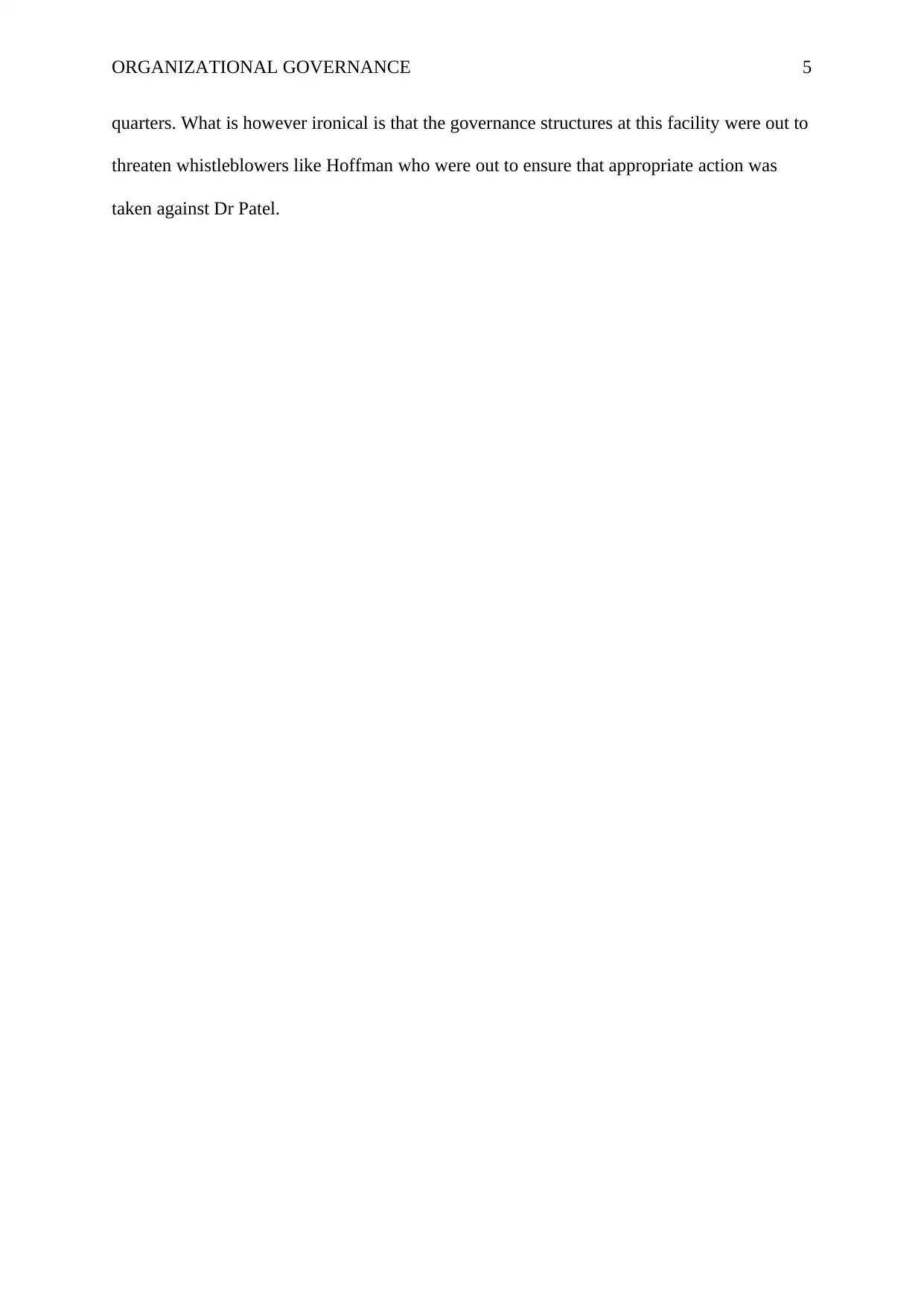
ORGANIZATIONAL GOVERNANCE 5
quarters. What is however ironical is that the governance structures at this facility were out to
threaten whistleblowers like Hoffman who were out to ensure that appropriate action was
taken against Dr Patel.
quarters. What is however ironical is that the governance structures at this facility were out to
threaten whistleblowers like Hoffman who were out to ensure that appropriate action was
taken against Dr Patel.
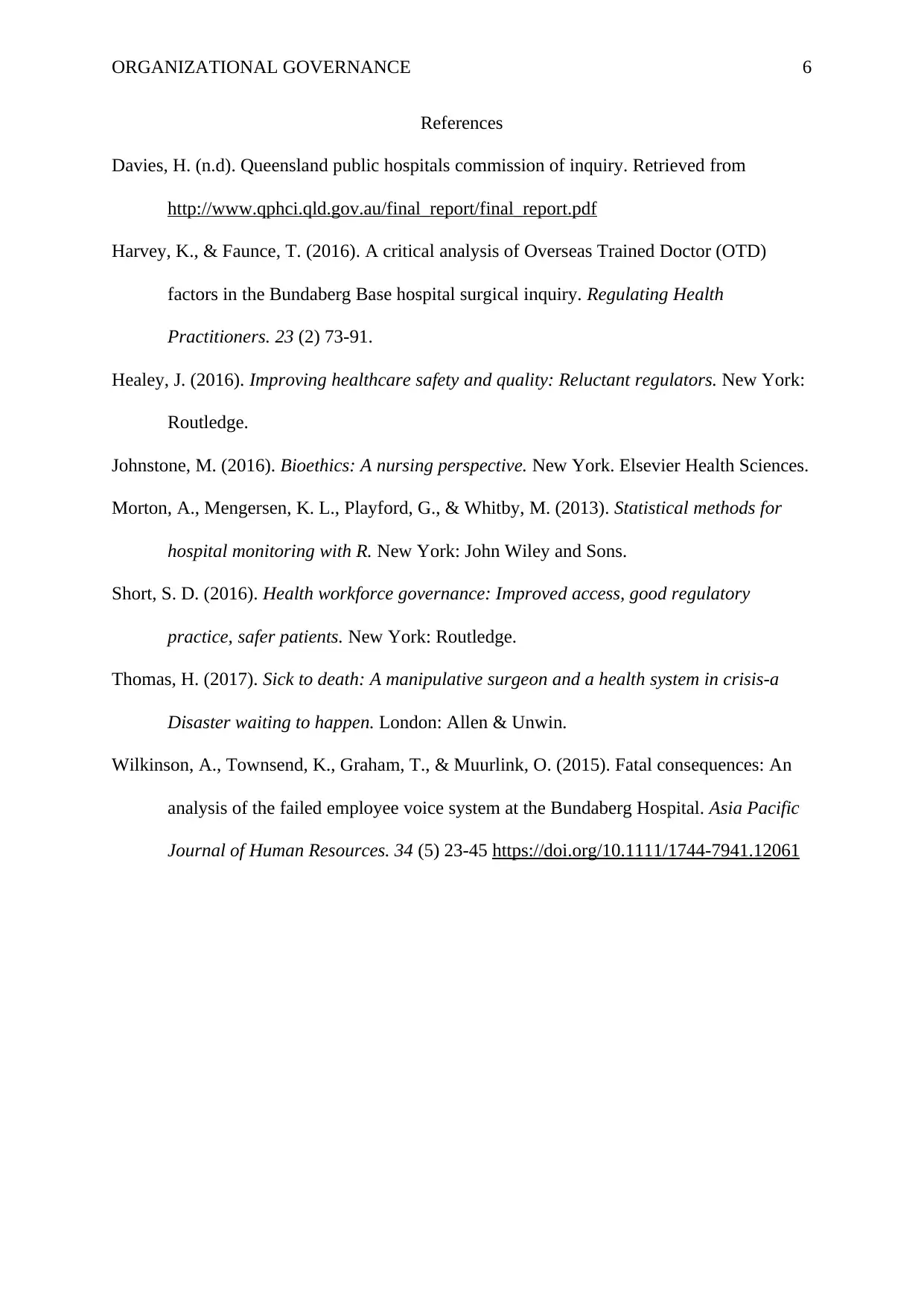
ORGANIZATIONAL GOVERNANCE 6
References
Davies, H. (n.d). Queensland public hospitals commission of inquiry. Retrieved from
http://www.qphci.qld.gov.au/final_report/final_report.pdf
Harvey, K., & Faunce, T. (2016). A critical analysis of Overseas Trained Doctor (OTD)
factors in the Bundaberg Base hospital surgical inquiry. Regulating Health
Practitioners. 23 (2) 73-91.
Healey, J. (2016). Improving healthcare safety and quality: Reluctant regulators. New York:
Routledge.
Johnstone, M. (2016). Bioethics: A nursing perspective. New York. Elsevier Health Sciences.
Morton, A., Mengersen, K. L., Playford, G., & Whitby, M. (2013). Statistical methods for
hospital monitoring with R. New York: John Wiley and Sons.
Short, S. D. (2016). Health workforce governance: Improved access, good regulatory
practice, safer patients. New York: Routledge.
Thomas, H. (2017). Sick to death: A manipulative surgeon and a health system in crisis-a
Disaster waiting to happen. London: Allen & Unwin.
Wilkinson, A., Townsend, K., Graham, T., & Muurlink, O. (2015). Fatal consequences: An
analysis of the failed employee voice system at the Bundaberg Hospital. Asia Pacific
Journal of Human Resources. 34 (5) 23-45 https://doi.org/10.1111/1744-7941.12061
References
Davies, H. (n.d). Queensland public hospitals commission of inquiry. Retrieved from
http://www.qphci.qld.gov.au/final_report/final_report.pdf
Harvey, K., & Faunce, T. (2016). A critical analysis of Overseas Trained Doctor (OTD)
factors in the Bundaberg Base hospital surgical inquiry. Regulating Health
Practitioners. 23 (2) 73-91.
Healey, J. (2016). Improving healthcare safety and quality: Reluctant regulators. New York:
Routledge.
Johnstone, M. (2016). Bioethics: A nursing perspective. New York. Elsevier Health Sciences.
Morton, A., Mengersen, K. L., Playford, G., & Whitby, M. (2013). Statistical methods for
hospital monitoring with R. New York: John Wiley and Sons.
Short, S. D. (2016). Health workforce governance: Improved access, good regulatory
practice, safer patients. New York: Routledge.
Thomas, H. (2017). Sick to death: A manipulative surgeon and a health system in crisis-a
Disaster waiting to happen. London: Allen & Unwin.
Wilkinson, A., Townsend, K., Graham, T., & Muurlink, O. (2015). Fatal consequences: An
analysis of the failed employee voice system at the Bundaberg Hospital. Asia Pacific
Journal of Human Resources. 34 (5) 23-45 https://doi.org/10.1111/1744-7941.12061
⊘ This is a preview!⊘
Do you want full access?
Subscribe today to unlock all pages.

Trusted by 1+ million students worldwide
1 out of 6
Related Documents
Your All-in-One AI-Powered Toolkit for Academic Success.
+13062052269
info@desklib.com
Available 24*7 on WhatsApp / Email
![[object Object]](/_next/static/media/star-bottom.7253800d.svg)
Unlock your academic potential
Copyright © 2020–2025 A2Z Services. All Rights Reserved. Developed and managed by ZUCOL.





